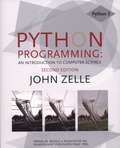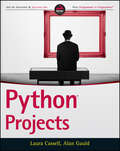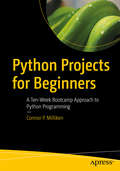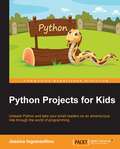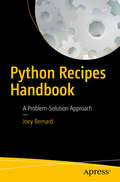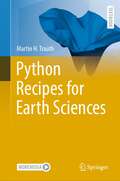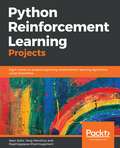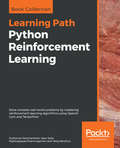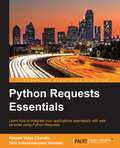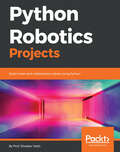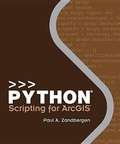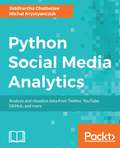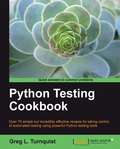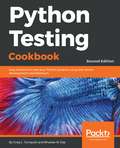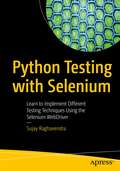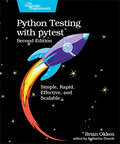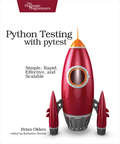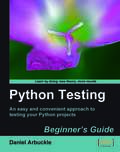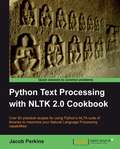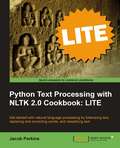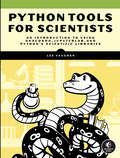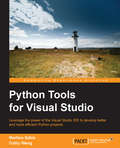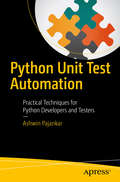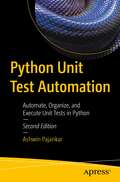- Table View
- List View
Python Programming: An Introduction to Computer Science
by John M. ZelleThis book is designed to be used as the primary textbook in a college-level first course in computing. It takes a fairly traditional approach, emphasizing problem solving, design, and programming as the core skills of computer science. However, these ideas are illustrated using a non-traditional language, namely Python.
Python Projects
by Alan Gauld Laura CassellA guide to completing Python projects for those ready to take their skills to the next levelPython Projects is the ultimate resource for the Python programmer with basic skills who is ready to move beyond tutorials and start building projects.The preeminent guide to bridge the gap between learning and doing, this book walks readers through the "where" and "how" of real-world Python programming with practical, actionable instruction. With a focus on real-world functionality, Python Projects details the ways that Python can be used to complete daily tasks and bring efficiency to businesses and individuals alike.Python Projects is written specifically for those who know the Python syntax and lay of the land, but may still be intimidated by larger, more complex projects. The book provides a walk-through of the basic set-up for an application and the building and packaging for a library, and explains in detail the functionalities related to the projects. Topics include:*How to maximize the power of the standard library modules*Where to get third party libraries, and the best practices for utilization*Creating, packaging, and reusing libraries within and across projects*Building multi-layered functionality including networks, data, and user interfaces*Setting up development environments and using virtualenv, pip, and moreWritten by veteran Python trainers, the book is structured for easy navigation and logical progression that makes it ideal for individual, classroom, or corporate training.For Python developers looking to apply their skills to real-world challenges, Python Projects is a goldmine of information and expert insight.
Python Projects for Beginners: A Ten-Week Bootcamp Approach to Python Programming
by Connor P. MillikenImmerse yourself in learning Python and introductory data analytics with this book’s project-based approach. Through the structure of a ten-week coding bootcamp course, you’ll learn key concepts and gain hands-on experience through weekly projects.Each chapter in this book is presented as a full week of topics, with Monday through Thursday covering specific concepts, leading up to Friday, when you are challenged to create a project using the skills learned throughout the week. Topics include Python basics and essential intermediate concepts such as list comprehension, generators and iterators, understanding algorithmic complexity, and data analysis with pandas. From beginning to end, this book builds up your abilities through exercises and challenges, culminating in your solid understanding of Python.Challenge yourself with the intensity of a coding bootcamp experience or learn at your own pace. With this hands-on learning approach, you will gain the skills you need to jumpstart a new career in programming or further your current one as a software developer. What You Will Learn Understand beginning and more advanced concepts of the Python languageBe introduced to data analysis using pandas, the Python Data Analysis libraryWalk through the process of interviewing and answering technical questionsCreate real-world applications with the Python languageLearn how to use Anaconda, Jupyter Notebooks, and the Python ShellWho This Book Is ForThose trying to jumpstart a new career into programming, and those already in the software development industry and would like to learn Python programming.
Python Projects for Kids
by Jessica IngrassellinoUnleash Python and take your small readers on an adventurous ride through the world of programming About This Book * Learn to start using Python for some simple programming tasks such as doing easy mathematical calculations. * Use logic and control loops to build a nice interesting game. * Get to grips with working with data and, once you're comfortable with that, you'll be introduced to Pygame, which will help you wrap up the book with a cool game. Who This Book Is For This book is for kids (aged 10 and over). This is book is intended for absolute beginners who lack any knowledge of computing or programming languages and want to get started in the world of programming. What You Will Learn * Start fiddling with Python's variables, build functions and interact with users * Build your own calculator using the Math Library * Train Python to make logical decisions * Work with moving 2D objects on-screen * Understand the Pygame Library and build your very own game! * Write a cool program to manage inventories in your backpack In Detail Kids are always the most fast-paced and enthusiastic learners, and are naturally willing to build stuff that looks like magic at the end (when it works!). Programming can be one such magic. Being able to write a program that works helps them feel they've really achieved something. Kids today are very tech-savvy and cannot wait to enter the fast-paced digital world. Because Python is one of the most popular languages and has a syntax that is quite simple to understand, even kids are eager to use it as a stepping stone to learning programming languages. This book will cover projects that are simple and fun, and teach kids how to write Python code that works. The book will teach the basics of Python programming, installation, and so on and then will move on to projects. A total of three projects, with each and every step explained carefully, without any assumption of previous experience. Style and approach The book will take a light approach in guiding the little readers through the world of Python. The main idea is to teach by example and let the readers have as much exercises to do, so that they learn faster and can apply their own ideas to the existing examples. The book should get them thinking, by the end, on where they can go next with such a powerful tool at their disposal.
Python Recipes Handbook
by Joey BernardLearn the code to write algorithms, numerical computations, data analysis and much more using the Python language: look up and re-use the recipes for your own Python coding. This book is your handy code cookbook reference. Whether you're a maker, game developer, cloud computing programmer and more, this is a must-have reference for your library. Python Recipes Handbook gives you the most common and contemporary code snippets, using pandas (Python Data Analysis Library), NumPy, and other numerical Python packages. What You'll LearnCode with the pandas (Python Data Analysis Library)Work with the various Python algorithms useful for today's big data analytics and cloud applicationsUse NumPy and other numerical Python packages and code for doing various kinds of analysisDiscover Python's new popular modules, packages, extensions and templates libraryWho This Book Is ForThis handy reference is for those with some experience with Python.
Python Recipes for Earth Sciences (Springer Textbooks in Earth Sciences, Geography and Environment)
by Martin H. TrauthPython is used in a wide range of geoscientific applications, such as in processing images for remote sensing, in generating and processing digital elevation models, and in analyzing time series. This book introduces methods of data analysis in the geosciences using Python that include basic statistics for univariate, bivariate, and multivariate data sets, time series analysis, and signal processing; the analysis of spatial and directional data; and image analysis. The text includes numerous examples that demonstrate how Python can be used on data sets from the earth sciences. The supplementary electronic material (available online through Springer Link) contains the example data as well as recipes that include all the Python commands featured in the book.
Python Recipes for Earth Sciences (Springer Textbooks in Earth Sciences, Geography and Environment)
by Martin H. TrauthPython is used in a wide range of geoscientific applications, such as in processing images for remote sensing, in generating and processing digital elevation models, and in analyzing time series. This book introduces methods of data analysis in the geosciences using Python that include basic statistics for univariate, bivariate, and multivariate data sets, time series analysis, and signal processing; the analysis of spatial and directional data; and image analysis. The text includes numerous examples that demonstrate how Python can be used on data sets from the earth sciences. Codes are available online through GitHub.
Python Reinforcement Learning Projects: Eight hands-on projects exploring reinforcement learning algorithms using TensorFlow
by Rajalingappaa Shanmugamani Sean Saito Yang WenzhuoDeploy autonomous agents in business systems using powerful Python libraries and sophisticated reinforcement learning modelsKey FeaturesImplement Q-learning and Markov models with Python and OpenAIExplore the power of TensorFlow to build self-learning modelsEight AI projects to gain confidence in building self-trained applicationsBook DescriptionReinforcement learning (RL) is the next big leap in the artificial intelligence domain, given that it is unsupervised, optimized, and fast. Python Reinforcement Learning Projects takes you through various aspects and methodologies of reinforcement learning, with the help of insightful projects.You will learn about core concepts of reinforcement learning, such as Q-learning, Markov models, the Monte-Carlo process, and deep reinforcement learning. As you make your way through the book, you’ll work on projects with various datasets, including numerical, text, video, and audio, and will gain experience in gaming, image rocessing, audio processing, and recommendation system projects. You’ll explore TensorFlow and OpenAI Gym to implement a deep learning RL agent that can play an Atari game. In addition to this, you will learn how to tune and configure RL algorithms and parameters by building agents for different kinds of games. In the concluding chapters, you’ll get to grips with building self-learning models that will not only uncover layers of data but also reason and make decisions.By the end of this book, you will have created eight real-world projects that explore reinforcement learning and will have handson experience with real data and artificial intelligence (AI) problems.What you will learnTrain and evaluate neural networks built using TensorFlow for RLUse RL algorithms in Python and TensorFlow to solve CartPole balancingCreate deep reinforcement learning algorithms to play Atari gamesDeploy RL algorithms using OpenAI UniverseDevelop an agent to chat with humans Implement basic actor-critic algorithms for continuous controlApply advanced deep RL algorithms to games such as MinecraftAutogenerate an image classifier using RLWho this book is forPython Reinforcement Learning Projects is for data analysts, data scientists, and machine learning professionals, who have working knowledge of machine learning techniques and are looking to build better performing, automated, and optimized deep learning models. Individuals who want to work on self-learning model projects will also find this book useful.
Python Reinforcement Learning: Solve complex real-world problems by mastering reinforcement learning algorithms using OpenAI Gym and TensorFlow
by Rajalingappaa Shanmugamani Sudharsan Ravichandiran Sean Saito Yang WenzhuoApply modern reinforcement learning and deep reinforcement learning methods using Python and its powerful libraries Key Features Your entry point into the world of artificial intelligence using the power of Python An example-rich guide to master various RL and DRL algorithms Explore the power of modern Python libraries to gain confidence in building self-trained applications Book Description Reinforcement Learning (RL) is the trending and most promising branch of artificial intelligence. This Learning Path will help you master not only the basic reinforcement learning algorithms but also the advanced deep reinforcement learning algorithms. The Learning Path starts with an introduction to RL followed by OpenAI Gym, and TensorFlow. You will then explore various RL algorithms, such as Markov Decision Process, Monte Carlo methods, and dynamic programming, including value and policy iteration. You'll also work on various datasets including image, text, and video. This example-rich guide will introduce you to deep RL algorithms, such as Dueling DQN, DRQN, A3C, PPO, and TRPO. You will gain experience in several domains, including gaming, image processing, and physical simulations. You'll explore TensorFlow and OpenAI Gym to implement algorithms that also predict stock prices, generate natural language, and even build other neural networks. You will also learn about imagination-augmented agents, learning from human preference, DQfD, HER, and many of the recent advancements in RL. By the end of the Learning Path, you will have all the knowledge and experience needed to implement RL and deep RL in your projects, and you enter the world of artificial intelligence to solve various real-life problems. This Learning Path includes content from the following Packt products: Hands-On Reinforcement Learning with Python by Sudharsan Ravichandiran Python Reinforcement Learning Projects by Sean Saito, Yang Wenzhuo, and Rajalingappaa Shanmugamani What you will learn Train an agent to walk using OpenAI Gym and TensorFlow Solve multi-armed-bandit problems using various algorithms Build intelligent agents using the DRQN algorithm to play the Doom game Teach your agent to play Connect4 using AlphaGo Zero Defeat Atari arcade games using the value iteration method Discover how to deal with discrete and continuous action spaces in various environments Who this book is for If you're an ML/DL enthusiast interested in AI and want to explore RL and deep RL from scratch, this Learning Path is for you. Prior knowledge of linear algebra is expected.
Python Requests Essentials
by Rakesh Vidya Chandra Bala Subrahmanyam VaranasiIf you are a Python administrator or developer interested in interacting with web APIs and have a passion for creating your own web applications, this is the book for you. Basic knowledge of Python programming, APIs, and web services will be an advantage.
Python Robotics Projects: Build smart and collaborative robots using Python
by Prof. Diwakar VaishLeverage the power of Python to build DIY robotic projects About This Book • Design, build, and stimulate collaborative robots • Build high-end robotics projects such as a customized personal Jarvis • Leverage the power of Python and ROS for DIY robotic projects Who This Book Is For If building robots is your dream, then this book is made for you. Prior knowledge of Python would be an added advantage. What You Will Learn • Get to know the basics of robotics and its functions • Walk through interface components with microcontrollers • Integrate robotics with the IoT environment • Build projects using machine learning • Implement path planning and vision processing • Interface your robots with Bluetooth In Detail Robotics is a fast-growing industry. Multiple surveys state that investment in the field has increased tenfold in the last 6 years, and is set to become a $100-billion sector by 2020. Robots are prevalent throughout all industries, and they are all set to be a part of our domestic lives. This book starts with the installation and basic steps in configuring a robotic controller. You'll then move on to setting up your environment to use Python with the robotic controller. You'll dive deep into building simple robotic projects, such as a pet-feeding robot, and more complicated projects, such as machine learning enabled home automation system (Jarvis), vision processing based robots and a self-driven robotic vehicle using Python. By the end of this book, you'll know how to build smart robots using Python. Style and approach A simple step-by-step guide to help you learn the concepts of robotics using simple to advanced steps. You'll not only learn the concepts of AI, machine learning, and Vision Processing, but also how to practically implement them in your projects.
Python Scripting For ArcGIS
by Paul A. ZandbergenThis book is a guide for experienced users of ArcGIS® Desktop to get started with Python scripting without needing previous programming experience. Experience with other scripting or programming languages (Perl, VBA, VB script, Java, C++) is helpful but not required. Readers are expected to have good general ArcGIS skills and a basic understanding of geoprocessing procedures.
Python Social Media Analytics
by Michal Krystyanczuk Siddhartha ChatterjeeIf you are a programmer or a data analyst familiar with the Python programming language and want to perform analyses of your social data to acquire valuable business insights, this book is for you. The book does not assume any prior knowledge of any data analysis tool or process.
Python Testing Cookbook
by Greg L. TurnquistThis cookbook is written as a collection of code recipes containing step-by-step directions on how to install or build different types of Python test tools to solve different problems. Each recipe contains explanations of how it works along with answers to common questions and cross references to other relevant recipes. The easy-to-understand recipe names make this a handy test reference book. Python developers and programmers with a basic understanding of Python and Python testing will find this cookbook beneficial. It will build on that basic knowledge equipping you with the intermediate and advanced skills required to fully utilize the Python testing tools. Broken up into lots of small code recipes, you can read this book at your own pace, whatever your experience. No prior experience of automated testing is required.
Python Testing Cookbook: Easy solutions to test your Python projects using test-driven development and Selenium, 2nd Edition
by Greg L. Turnquist Bhaskar N. DasFix everyday testing problems in Python with the help of this solution-based guideKey FeaturesUse powerful tools such as doctest and unittest to make testing convenientApply automation testing to an existing legacy system that isn't test orientedA practical guide to ease testing in Python using real-world examplesBook DescriptionAutomated testing is the best way to increase efficiency while reducing the defects of software testing. It helps find bugs in code easily and at an early stage so that they can be tackled efficiently. This book delves into essential testing concepts used in Python to help you build robust and maintainable code.Python Testing Cookbook begins with a brief introduction to Python's unit testing framework to help you write automated test cases. You will learn how to write suitable test sets for your software and run automated test suites with Nose. You will then work with the unittest.mock library, which allows you to replace the parts of your system that are being tested with mock objects and make assertions about how they have been used. You will also see how to apply Test-driven Development (TDD) and Behavior-driven Development (BDD) and how to eliminate issues caused by TDD. The book explains how to integrate automated tests using Continuous Integration and perform smoke/load testing. It also covers best practices and will help you solve persistent testing issues in Python. The book concludes by helping you understand how doctest works and how Selenium can be used to test code efficiently. What you will learnRun test cases from the command line with increased verbosityWrite a Nose extension to pick tests based on regular expressionsCreate testable documentation using doctestUse Selenium to test the Web User InterfaceWrite a testable story with Voidspace Mock and NoseConfigure TeamCity to run Python tests on commitUpdate project-level scripts to provide coverage reportsWho this book is forIf you’re a Python developer who wants to take testing to the next level and would like to expand your testing skills, this book is for you. It is assumed that you have some Python programming knowledge.
Python Testing with Selenium: Learn to Implement Different Testing Techniques Using the Selenium WebDriver
by Sujay RaghavendraImplement different testing techniques using Selenium WebDriver with the Python programming language. This quick reference provides simple functional test cases with a syntax-based approach for Selenium WebDriver. You’ll begin by reviewing the basics of Selenium WebDriver and its architectural design history and then move on to the configuration and installation of Selenium library for different web browsers, including the basic commands needed to start test scripts in various browsers. You’ll review action commands of keyboard and mouse for testing user interactions in a web page and see how hyperlinks are tested. The book also examines various web elements using eight different locators provided by Selenium to help you choose the one best suited to your needs. All Python scripts are ready to test real examples, all of which are explained thoroughly with problem statements. You’ll use different Python design patterns to automate test scripts that can be incorporated with Selenium. In the end, Python Testing with Selenium will provide you with the expertise to write your own test cases in future. What You’ll Learn Install and configure Selenium WebDriver with Python for different web-browsers Review basic commands of Selenium Locate web elements Work with UI based web elements Assert web elements and handle exceptions Write test scripts in Page Object Model Write test cases with Unittest framework Who This Book Is For Python developers/testers who want to test their web applications
Python Testing with pytest
by Brian OkkenTest applications, packages, and libraries large and small with pytest, Python's most powerful testing framework. pytest helps you write tests quickly and keep them readable and maintainable. In this fully revised edition, explore pytest's superpowers - simple asserts, fixtures, parametrization, markers, and plugins - while creating simple tests and test suites against a small database application. Using a robust yet simple fixture model, it's just as easy to write small tests with pytest as it is to scale up to complex functional testing. This book shows you how. pytest is undeniably the best choice for testing Python projects. It's a full-featured, flexible, and extensible testing framework. pytest's fixture model allows you to share test data and setup procedures across multiple layers of tests. The pytest framework gives you powerful features such as assert rewriting, parametrization, markers, plugins, parallel test execution, and clear test failure reporting - with no boilerplate code. With simple step-by-step instructions and sample code, this book gets you up to speed quickly on this easy-to-learn yet powerful tool. Write short, maintainable tests that elegantly express what you're testing. Speed up test times by distributing tests across multiple processors and running tests in parallel. Use Python's builtin assert statements instead of awkward assert helper functions to make your tests more readable. Move setup code out of tests and into fixtures to separate setup failures from test failures. Test error conditions and corner cases with expected exception testing, and use one test to run many test cases with parameterized testing. Extend pytest with plugins, connect it to continuous integration systems, and use it in tandem with tox, mock, coverage, and even existing unittest tests. Write simple, maintainable tests quickly with pytest. What You Need: The examples in this book were written using Python 3.10 and pytest 7. pytest 7 supports Python 3.5 and above.
Python Testing with pytest: Simple, Rapid, Effective, and Scalable
by Brian OkkenDo less work when testing your Python code, but be just as expressive, just as elegant, and just as readable. The pytest testing framework helps you write tests quickly and keep them readable and maintainable - with no boilerplate code. Using a robust yet simple fixture model, it's just as easy to write small tests with pytest as it is to scale up to complex functional testing for applications, packages, and libraries. This book shows you how. For Python-based projects, pytest is the undeniable choice to test your code if you're looking for a full-featured, API-independent, flexible, and extensible testing framework. With a full-bodied fixture model that is unmatched in any other tool, the pytest framework gives you powerful features such as assert rewriting and plug-in capability - with no boilerplate code. With simple step-by-step instructions and sample code, this book gets you up to speed quickly on this easy-to-learn and robust tool. Write short, maintainable tests that elegantly express what you're testing. Add powerful testing features and still speed up test times by distributing tests across multiple processors and running tests in parallel. Use the built-in assert statements to reduce false test failures by separating setup and test failures. Test error conditions and corner cases with expected exception testing, and use one test to run many test cases with parameterized testing. Extend pytest with plugins, connect it to continuous integration systems, and use it in tandem with tox, mock, coverage, unittest, and doctest. Write simple, maintainable tests that elegantly express what you're testing and why. What You Need: The examples in this book are written using Python 3.6 and pytest 3.0. However, pytest 3.0 supports Python 2.6, 2.7, and Python 3.3-3.6.
Python Testing: Beginner's Guide
by Daniel ArbuckleThe book begins with the very foundations of automated testing, and expands on them until the best-practice tools and techniques are fully covered. New concepts are illustrated with step-by-step hands-on exercises. Testing will be easier and more enjoyable with this beginner's guide. If you are a Python developer and want to write tests for your applications, this book will get you started and show you the easiest way to learn testing. You need to have sound Python programming knowledge to follow along. An awareness of software testing would be good, but no formal knowledge of testing is expected nor do you need to have any knowledge of the libraries discussed in the book.
Python Text Processing with NLTK 2.0 Cookbook
by Jacob PerkinsThe learn-by-doing approach of this book will enable you to dive right into the heart of text processing from the very first page. Each recipe is carefully designed to fulfill your appetite for Natural Language Processing. Packed with numerous illustrative examples and code samples, it will make the task of using the NLTK for Natural Language Processing easy and straightforward. This book is for Python programmers who want to quickly get to grips with using the NLTK for Natural Language Processing. Familiarity with basic text processing concepts is required. Programmers experienced in the NLTK will also find it useful. Students of linguistics will find it invaluable.
Python Text Processing with NLTK 2.0 Cookbook: LITE
by Jacob PerkinsThe learn-by-doing approach of this book will enable you to dive right into the heart of text processing from the very first page. Each recipe is carefully designed to fulfill your appetite for Natural Language Processing. Packed with numerous illustrative examples and code samples, it will make the task of using the NLTK for Natural Language Processing easy and straightforward. This book is for Python programmers who want to quickly get to grips with using the NLTK for Natural Language Processing. Familiarity with basic text processing concepts is required. Programmers experienced in the NLTK will also find it useful. Students of linguistics will find it invaluable.
Python Tools for Scientists: An Introduction to Using Anaconda, JupyterLab, and Python's Scientific Libraries
by Lee VaughanAn introduction to the Python programming language and its most popular tools for scientists, engineers, students, and anyone who wants to use Python for research, simulations, and collaboration.Python Tools for Scientists will introduce you to Python tools you can use in your scientific research, including Anaconda, Spyder, Jupyter Notebooks, JupyterLab, and numerous Python libraries. You&’ll learn to use Python for tasks such as creating visualizations, representing geospatial information, simulating natural events, and manipulating numerical data.Once you&’ve built an optimal programming environment with Anaconda, you&’ll learn how to organize your projects and use interpreters, text editors, notebooks, and development environments to work with your code. Following the book&’s fast-paced Python primer, you&’ll tour a range of scientific tools and libraries like scikit-learn and seaborn that you can use to manipulate and visualize your data, or analyze it with machine learning algorithms.You&’ll also learn how to:Create isolated projects in virtual environments, build interactive notebooks, test code in the Qt console, and use Spyder&’s interactive development featuresUse Python&’s built-in data types, write custom functions and classes, and document your codeRepresent data with the essential NumPy, Matplotlib, and pandas librariesUse Python plotting libraries like Plotly, HoloViews, and Datashader to handle large datasets and create 3D visualizationsRegardless of your scientific field, Python Tools for Scientists will show you how to choose the best tools to meet your research and computational analysis needs.
Python Tools for Visual Studio
by Cathy Wang Martino SabiaThis is a hands-on guide that provides exemplary coverage of all the features and concepts related to PTVS. The book is intended for developers who are aiming to enhance their productivity in Python projects with automation tools that Visual Studio provides for the .Net community. Some basic knowledge of Python programming is essential.
Python Unit Test Automation
by Ashwin PajankarQuickly learn how to automate unit testing of Python 3 code with Python 3 automation libraries, such as doctest, unittest, nose, nose2, and pytest. This book explores the important concepts in software testing and their implementation in Python 3 and shows you how to automate, organize, and execute unit tests for this language. This knowledge is often acquired by reading source code, manuals, and posting questions on community forums, which tends to be a slow and painful process. Python Unit Test Automation will allow you to quickly ramp up your understanding of unit test libraries for Python 3 through the practical use of code examples and exercises. All of which makes this book a great resource for software developers and testers who want to get started with unit test automation in Python 3 and compare the differences with Python 2. This short work is your must-have quick start guide to mastering the essential concepts of software testing in Python. What You'll Learn: Essential concepts in software testing Various test automation libraries for Python, such as doctest, unittest, nose, nose2, and pytest Test-driven development and best practices for test automation in Python Code examples and exercises Who This Book Is For: Python developers, software testers, open source enthusiasts, and contributors to the Python community
Python Unit Test Automation: Automate, Organize, and Execute Unit Tests in Python
by Ashwin PajankarLearn how to automate unit tests of Python 3 with automation libraries, such as doctest, unittest, nose, nose2, pytest, and selenium. This book explores important concepts in software test automation and demonstrates how to automate, organize, and execute unit tests with Python. It also introduces readers to the concepts of web browser automation and logging.This new edition starts with an introduction to Python 3. Next, it covers doctest and pydoc. This is followed by a discussion on unittest, a framework that comes packaged with Python 3 itself. There is a dedicated section on creating test suites, followed by an explanation of how nose2 provides automatic test module discovery. Moving forward, you will learn about pytest, the most popular third-party library and testrunner for Python. You will see how to write and execute tests with pytest. You’ll also learn to discover tests automatically with pytest.This edition features two brand new chapters, the first of which focuses on the basics of web browser automation with Selenium. You’ll learn how to use Selenium with unittest to write test cases for browser automation and use the Selenium IDE with web browsers such as Chrome and Firefox. You’ll then explore logging frameworks such as Python’s built-in logger and the third-party framework loguru.The book concludes with an exploration of test-driven development with pytest, during which you will execute a small project using TDD methodology.What You Will LearnStart testing with doctest and unittestUnderstand the idea of unit testingGet started with nose 2 and pytestLearn how to use logger and loguruWork with Selenium and test driven development Who This Book Is ForPython developers, software testers, open source enthusiasts, and contributors to the Python community.
